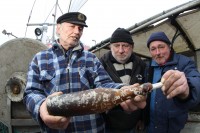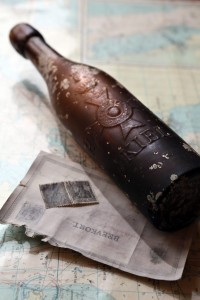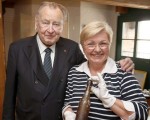 When Konrad Fischer, skipper of the Maria I, found a brown bottle in his net while fishing in the Baltic off the city of Kiel in the northern German state of Schleswig-Holstein, he figured it was just a common beer bottle and went to throw it back into the sea. One of his crew members stopped him, noticing that there seemed to be something inside. They opened up the bottle — the porcelain cap was crumbling anyway — and found a Danish postcard rolled up inside. There was writing on the postcard but much of it was too faded to read. The only clearly identifiable elements were a message written in German asking that the card be sent to an address in Berlin and two five-Pfenning stamps to pay for postage.
When Konrad Fischer, skipper of the Maria I, found a brown bottle in his net while fishing in the Baltic off the city of Kiel in the northern German state of Schleswig-Holstein, he figured it was just a common beer bottle and went to throw it back into the sea. One of his crew members stopped him, noticing that there seemed to be something inside. They opened up the bottle — the porcelain cap was crumbling anyway — and found a Danish postcard rolled up inside. There was writing on the postcard but much of it was too faded to read. The only clearly identifiable elements were a message written in German asking that the card be sent to an address in Berlin and two five-Pfenning stamps to pay for postage.
 The postcard was dated May 17th, 1913, just two months short of 101 years before it was fished out of the sea, which makes it the oldest message in a bottle ever found. The previous record holder was found in 2012, almost 98 years after it was sent. Excited by its advanced age, Fischer brought the bottle and its message to the International Maritime Museum in Hamburg where researchers set about finding out more about the sender.
The postcard was dated May 17th, 1913, just two months short of 101 years before it was fished out of the sea, which makes it the oldest message in a bottle ever found. The previous record holder was found in 2012, almost 98 years after it was sent. Excited by its advanced age, Fischer brought the bottle and its message to the International Maritime Museum in Hamburg where researchers set about finding out more about the sender.
The address in Berlin led them to identify him as Richard Platz, the son of a baker who was 20 years old in 1913. He was hiking on the Baltic coast with a nature appreciation group when he threw the bottle in the sea. Platz was just 54 when he died in 1946. He was survived by two daughters, Gudrun and Sieglinde, neither of them still living. Berlin genealogist Veit Godoj was able to locate Sieglinde’s daughter, one Angela Erdmann, now 62, who was born six years after her grandfather’s death.
 On March 13th, Godoj contacted Erdmann and told her they’d found a message from the grandfather she never knew. Deeply moved by the discovery, she immediately called her cousin Dagmar Born who has been researching the family history for some years. Born sent her cousin a number of Platz’s documents, letters and photographs. The handwriting on the letters confirmed that he was indeed the author of the message in the bottle. It’s possible the bottle has a family connection as well, since his wife, Ella’s father owned a brewery.
On March 13th, Godoj contacted Erdmann and told her they’d found a message from the grandfather she never knew. Deeply moved by the discovery, she immediately called her cousin Dagmar Born who has been researching the family history for some years. Born sent her cousin a number of Platz’s documents, letters and photographs. The handwriting on the letters confirmed that he was indeed the author of the message in the bottle. It’s possible the bottle has a family connection as well, since his wife, Ella’s father owned a brewery.
 The whole family is excited by the find. Erdmann says it has brought them closer together as they look into the family history. They plan to go visit the bottle and message currently on display at the International Maritime Museum until May 1st. After that, researchers will take it out of public view to work on deciphering the faded text.
The whole family is excited by the find. Erdmann says it has brought them closer together as they look into the family history. They plan to go visit the bottle and message currently on display at the International Maritime Museum until May 1st. After that, researchers will take it out of public view to work on deciphering the faded text.
Its ultimate fate is unknown at this time. The finder Konrad Fischer owns it now, and he has only loaned it to the museum. He could sell it or keep it once he gets it back.
Most interesting. Many years ago I found a bottle with a message in it while beachcombing along the shores of Pudget Sound, Washington State. It was one of a number of bottles put out in different places/currents of the Pacific Ocean by Skripps Institute of Oceanography, UC San Diego, which conducts global science research. I notified them when and where I had found the bottle and accompanying note. It was quite exciting, finding the bottle and note – what some part of us longs for, it seems.
That is so cool. I vaguely recall seeing an article a few months ago about someone finding one of those current testers decades after it was sent out. Ah yes, here it is. It was from the Woods Hole Oceanographic Institution, sent from Cape Cod in 1956, retrieved in Nova Scotia in 2014.
If he was 10 in 1913, then that picture of him and the fiancée in 1917 would have been taken when he was 14. I bring this up only because it makes me jealous of the obviously superior German moustache gene.
No need to be jealous. That was my typo. He was 20 in May of 1913. Having said that, there’s probably still some cause for jealousy because those are truly splendid whiskers.
He marries a very attractive woman whose parents own a brewery? Isn’t that the definition of the perfect “10”?
Great story. In the 1917 Richard is in uniform, and unless I am mistaken, the ribbon worn at the second button hole is a wound badge, given only for combat related injuries. The cuffs, collar, and shoulder tabs would reveal his regiment and rank. No doubt the folks at Osprey Publishing (London,UK) or any of the Veterans Associations in Germany could provide more detailed information.
I threw a ketchup bottle into the St Lawrence River in September, 1957. In October of 1958 I received a letter from a farmer in County Mayo, Ireland telling me he found my bottle on the strand. He and I corresponded for 20 years until his death and his cousin and I have kept the correspondence going. I just received her St. Patrick’s Day card.
Fascinating, Livius – These messages in bottles do get around.